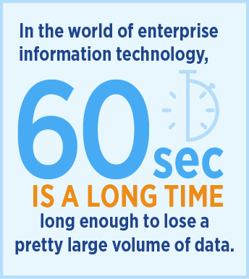Subscribe to our blog
Thanks for subscribing to the blog.
September 4, 2016
Topics: Cloud Volumes ONTAP High Availability3 minute read

Massive cloud storage solutions offer many "9s" in their SLAs. For instance, 99.99% uptime, but are they enough? For enterprises and small businesses that need continuous availability, high uptime might not be enough. Let's look at some of the reasons why it's important to have a bridge of support in the form of a secondary enterprise storage solution:
Forget Uptime, What About Recovery Time?
One of the points we're trying to make is that moving your physical storage infrastructure over to the cloud isn't a bad idea. With that said, one of the crucial factors in the success or failure of a cloud implementation is structure.
No matter how many nines your SLA contains, downtime is still an inevitability. Structure is what's going to determine how fast your cloud deployment bounces back.
Let's say that a server in one of your High Availability zones goes down, carrying part of your application with it. By configuring your secondary storage node in a different Highly Available zone, and utilizing a service such as NetApp's SnapMirror, you can instantly shift resources to the functional node.
With this architecture in place, the Recovery Time Objective (RTO) can be as short as sixty seconds—barely enough time for your customers to notice what they're missing.
What About Data Loss?
In the world of enterprise information technology, sixty seconds is a long time—long enough to lose a pretty large volume of data. That's why it's also important to talk about the Recovery Point Objective (RPO) in addition to the RTO.
With a properly-configured secondary storage solution, the RPO is essentially zero. The secondary node will begin active processing of the data as soon as a service interruption is detected, so no data is lost.
What About Flexibility?
Flexibility is another major factor for enterprise secondary storage. Do you run applications that consume large amounts of storage, bandwidth, or processing power—but only for a short amount of time?
Maintaining the amount of storage to support these applications can be expensive, especially when it tends to lie dormant most of the time. By using enterprise secondary storage, however, this particular storage concern evaporates.
First of all, NetApp's Cloud Volumes ONTAP (formerly ONTAP Cloud) can quickly spin up and spin down large volumes of cloud storage for use by the enterprise. The genius of enterprise secondary storage, however, is in the provisioning of these volumes.
Using a service like SnapMirror, administrators can take a snapshot of one of these storage-intensive services right before it gets shut down.
This snapshot is extremely lightweight. It only records the data that changed since the last time the application was instantiated. This means that once the application is re-provisioned from secondary storage, it can be done in the blink of an eye.
Using NetApp for Secondary Enterprise Cloud Storage
Cutting down on recovery time doesn't just save administrators a lot of work, it also helps retain customers who depend on your application being available 100 percent of the time. Similarly, reducing the footprint of resource-intensive applications saves time and money.
![]() These are just a few of the ways that enterprises can unlock the power of secondary storage by using NetApp's Cloud Volumes ONTAP, SnapMirror, and other innovative solutions.
These are just a few of the ways that enterprises can unlock the power of secondary storage by using NetApp's Cloud Volumes ONTAP, SnapMirror, and other innovative solutions.
For more information, and ideas on how to use NetApp High Availability storage to support cloud and on-premise applications, click here or contact us.
Want to get started? Try out Cloud Volumes ONTAP today with a 30-day free trial.

